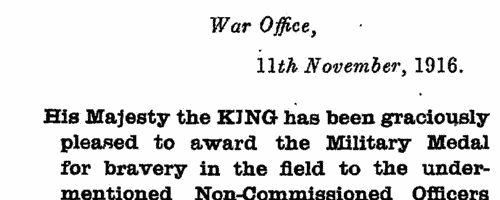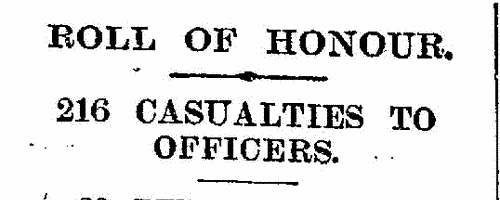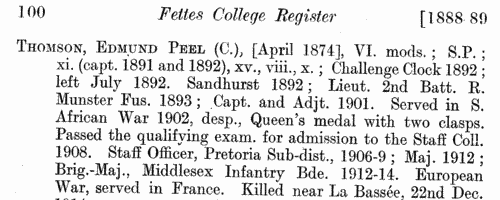Add this eBook to your basket to receive access to all 222 records. Our indexes include entries for the spelling keay. In the period you have requested, we have the following 222 records (displaying 171 to 180): These sample scans are from the original record. You will get scans of the full pages or articles where the surname you searched for has been found. Your web browser may prevent the sample windows from opening; in this case please change your browser settings to allow pop-up windows from this site. Members of Durham University
(1910)
The alphabetical list of all living members of Durham University, issued in 1910, was compiled from the Admission Book and University Register. It gives surname, initials, degree, college, and date. Those marked with an asterisk were Members of Convocation. In the case of graduates in Arts, Theology (except in the case of Bachelors of Divinity) and Civil Law, the dates refer to the year in which the examination for the degree of B.A. was passed; in the case of Bachelors of Divinity who were not Graduates in Arts, of Licentiates in Theology, of Civil Engineers, and of Licentiates in Medicine, to the year in which each passed the Final Examination. In the case of Hygiene, Science, and Music, to the year in which the Examination for B.Hy., B.Sc., or B.Mus. was passed; and in the case of Graduates in Medicine to the year in which the Examination for the degree of M.B. was passed, except in the case of practitioners, when the date refers to the year in which the examination for the degree specified was passed. In cases where no date is given the degree is Ad Eundem, unless it is marked honorary. The abbreviations are: Arms., Armstrong College, Newcastle-upon-Tyne; Codr., Codrington College, Barbados; Cos., Bishop Cosin's Hall; F. Bay, Fourah Bay, Sierra Leone; Hatf., Bishop Hatfield's Hall; Med., College of Medicine, Newcastle-upon-Tyne; St. Chad's, St Chad's Hall; St. John's, St John's Hall; Univ., University College. | Sample scan, click to enlarge

|  London Metropolitan Police
(1902-1911) London Metropolitan Police
(1902-1911)
The London Metropolitan Police Register of Joiners (MEPO 4/337) lists policemen joining the force 14 July 1902 to 10 April 1911 (warrant numbers 88812 to 100006). The register is alphabetical, in so far as the recruits are listed chronologically grouped under first letters of surname. It gives Date of Appointment, Name, Number of Warrant, Cause of Removal from Force (resigned, dismissed, promoted or died), and Date of Removal. The information about removal is sometimes wanting. A final column of 'Remarks' is largely blank, but occasionally gives an alias or a cross-reference to another warrant number. The register is discoloured and damaged in places, and one or two pages are missing. | Sample scan, click to enlarge

| Military Medal for Bravery in the Field
(1916)
King George V awarded the Military Medal for bravery in the field to these Non-Commissioned Officers and Men 11 November 1916. | Sample scan, click to enlarge

| Officers missing: Australian Infantry
(1916)
Lists of names of soldiers wounded, died of wounds, died, missing presumed dead, and taken prisoner by the enemy, were issued to the British national press under the title Roll of Honour. Each man is identified by surname, initials and number. The regimental returns from which the daily Roll was compiled were made up over the previous week or weeks. Each regimental return may be partial, covering only part of the alphabet. The lists are provisional, in that a man reported wounded one day may appear as died of wounds later; a missing presumed dead may later be reported as having been found, or as having died; the lists of prisoners of war were provided by the enemy and will relate to captures weeks earlier. However, these rolls are the most comprehensive single source of names of British and allied combatants meeting with misfortune in the Great War. This is the roll published 3 August 1916. | Sample scan, click to enlarge

| Grenadier Guards Died in the Great War: Guardsmen
(1914-1918)
203 officers and 4508 other ranks of the Grenadier Guards were killed in the Great War; 242 officers and 6939 men were wounded. This nominal roll lists all the warrant officers, non-commissioned officers and men killed in action, or who died of wounds or disease, in the European war of 1914 to 1918. Arranged alphabetically for each rank, the roll gives regimental number, surname and initials. | Sample scan, click to enlarge

| Roll of Honour: London Teaching Staff
(1914-1918)
The London County Council published a 'Record of Service in the Great War 1914-1918 by Members of the Council's Staff' in 1922. This included a complete list, department by department, of the over 7000 staff who had served in the armed forces during the war, those dying while on active service being marked with an asterisk. The entries give full name, surname first, in bold, the years in uniform, any decorations, rank, and a brief description of theatre in which engaged. | Sample scan, click to enlarge

| Chemists and Druggists
(1919)
The official register printed under the direction of the Pharmaceutical Society of Great Britain pursuant to the act of 31 & 32 Victoriae, cap. 121 (An Act to Regulate the Sale of Poisons, and Alter and Amend the Pharmacy Act, 1852) comprised two sections:
1.The Register of Pharmaceutical Chemists, giving date of registration, number of examination certificate, full name (surname first, in capitals), and residence;
2. The Register of Chemists and Druggists, giving date of registration, full name (surname first, in capitals), residence, number of examination certificate (major or minor), and qualification. | Sample scan, click to enlarge

| Subscribers to the Equipment Fund for the Birmingham City Battalions in the Great War
(1919)
The 14th, 15th and 16th battalions of the Royal Warwickshire Regiment were raised from the city of Birmingham, and a public subcription raised £50,000 towards providing the men with 'somewhat better clothing and certain necessary articles not included in the official kit and accoutrements'. | Sample scan, click to enlarge

| Boys entering Fettes College, Edinburgh
(1920)
Fettes College, Edinburgh, was opened in 1870 under the terms of a trust 'for maintenance, education, and outfit of young people whose parents have either died without leaving sufficient funds for that purpose, or who, from innocent misfortune during their own lives, are unable to give suitable education to their children'. In 1923 this edition of the Fettes College Register was published; in it the compilers sought to set out for each boy who had attended the college a brief synopsis of what was known about his time at the school, his subsequent career, and date and place of death, or address as of 1923. Of course, for most of the boys entering the school after 1916, they were still at school, and their career was still ahead of them. After each name there is a letter in brackets indicating the house to which the pupil belonged - (C.) Carrington House; (G.) Glencorse House; (K.) Kimmerghame House; (M.) Moredun House; (S.) Schoolhouse. An asterisk indicates that the boy was a foundationer, i. e. supported by the foundation; a dagger that he was a foundation scholar. VIA. indicates Upper Form; Mods. Modern School; Army Cl., Army Class; S. P., School Prefect; xx. First Rugby Football Twenty; xv. First Rugby Football Fifteen; xx. cap. Caps occasionally given to the five (or fewer) next to the First Fifteen after 1875; xi. First Cricket Eleven; viii. Gymnastic Eight; Trs. Prizes and Exhib., Trustees' Prizes and Exhibitions; Govs. Prizes and Exhib., Governors' Prizes and Exhibitions; Schol., scholarship; M., married. Month and year of birth is given in square brackets. | Sample scan, click to enlarge

| Medical Practitioners in Scotland
(1926)
The Medical Directory was split into several sections. The Scottish section covered all medical practitioners resident within Scotland. Each year a schedule was sent to each doctor to be returned to the publishers, so as to keep the directory up to date. In the directory the doctor's name is given first, in bold, surname first, in capitals; then current address. Next are the qualifications; the italic abbreviations in parentheses following the qualifications indicate the medical school at which they were gained. Then there is a list of posts and honours within the profession, starting with those then current; previous posts are preceded by the word 'late'. Finally, brief details are given of any publications. | Sample scan, click to enlarge

|
Research your ancestry, family history, genealogy and one-name study by direct access to original records and archives indexed by surname.
|












